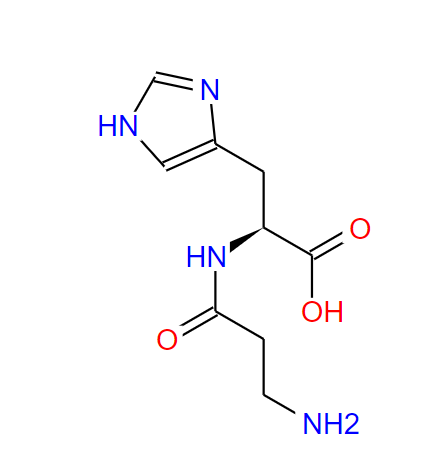L-carnosine is a small molecule with a natural dipeptide L-shaped structure that is commonly found in nature and is composed of natural dipeptide L-shaped structures commonly found in nature. A dipeptide composed of β-alanine and L-histidine. Carnosine has a variety of cellular antioxidant, anti-aging and physiological health care functions and medical effects, such as hypertension, heart disease, senile cataract, ulcer recovery, anti-tumor, immune model test, anti-stress factors and so on.
Role of
Carnosine is a carnosine found by Russian scientist Gulevich together with carnitine. In the United Kingdom, Korea, Russia, and other China, studies have shown that carnosine has a strong antioxidant capacity and is beneficial to humans. Carnosine has been shown to remove reactive oxygen species (ROS) formed by excessive oxidation of fatty acids in cell membrane during oxidative stress, as well as α-β unsaturated aldehydes.
Many studies have found that N-acetylcarnosine has a good effect in the prevention and treatment of cataract. One of these studies showed that carnosine ameliorated cataracts caused by crystalline opacities in rats induced by exposure to guanidine. Although these claims support a number of hypothetical benefits to the eye such as carnotin treatment for cataracts, they have, to date, not been fully supported by the mainstream medical community. The Royal Orthopedics, for example, had claimed that carnosine was neither safe nor effective in the topical treatment of cataracts.
According to a 2002 report, carnosine can improve social relationships and increase the vocabulary used by children with autism, but the improvements claimed in the study could also come from improvements, placebo, or other factors not written in this survey.
Method of synthesis
At present, the production methods of carnosine have some common shortcomings: due to the limitation of side reaction, this side reaction is carried out with the participation of L-histidine imidazole ring. L-histidine will rotate at least 0.8% in the reaction process, reducing the product yield; At the same time, it is difficult to separate L-carnosine with good pure optical purity from harmful mixtures (its rotation mode, imidazole isomers, etc.), affecting commercial purity, because these mixtures have similar physicochemical properties to L-carnosine. Due to the presence of these mixtures, the resulting L-carnosine is toxic, rather than the original pure preparation.
The new method of L-carnosine production is as follows: phthalic anhydride reacts β-alanine with phthalic anhydride β-phthaloylalanine, chlorinated reagent chlorides phthaloyl-β-phthaloylalanine to phthaloyl-alanine β-alanyl chloride; L-trialkylsilane protective compound reacts with trialkylchlorosilane or hexahydroxysilane, reacts with phthalyl β-alanyl chloride condensation of hydrochloride, removes the protective group with anhydrous alcohol, and synthetates hydrochloride in alkaline solution to obtain the intermediate synthesis product, hydrazine hydrate hydrolyzates hydrochloride, and precipitates L-carnosine in anhydrous alcohol. This product is an imidazole ring on L-protected histidine to avoid the side effects of imidazole ring on L-histidine and other substances, and obtain pure L-carnosine with low side effects and high total yield and content.
Post time: Oct-24-2023

